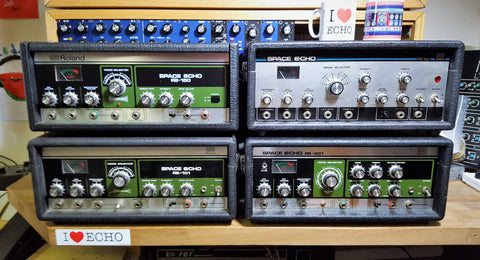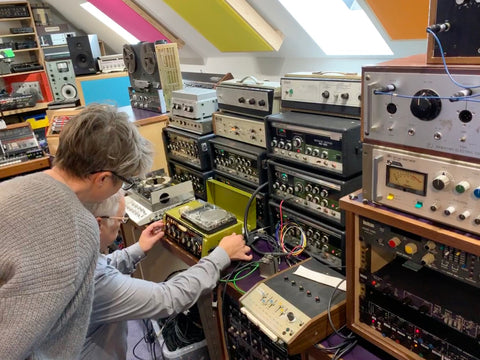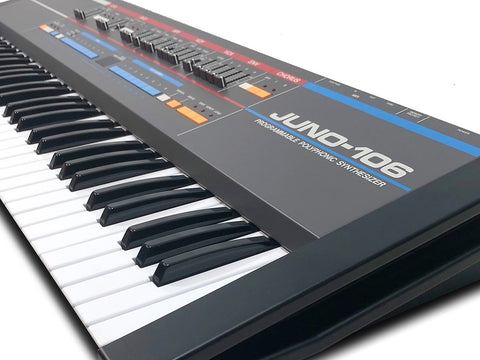EMS Synthi HiFli by Tony Miln
Oct 03 2018 1 Comment Tags: David Gilmour, EMS, Gear History, Guitar Pedal, Guitar Synth, Pink Floyd, Synthesizer, Synthi HiFli
The EMS Synthi HiFli by Tony Miln
If you’re a guitar pedal nerd, then the EMS Synthi HiFli is the pinnacle of desirability: it is the stuff of legend; a rare and much-mythologised beast that is seldom-sighted - sporting many sliders with alluring names. In his book, ‘Analog Man’s Guide To Vintage Effects’, Tom Hughes officially anointed the HiFli king of kings - rarest of the rare - big chief amongst the hen’s teeth.
In short, the EMS Synthi HiFli is the ultimate vintage guitar ‘pedal’; good examples are very few and far between. I set out many years ago now to try and find one - the combination of at last being able to play something bearing the hallowed name of EMS (a Synthi or VCS3 both being unaffordable) and its reputation as the ultimate guitar synth spurring me on. I eventually found one at a price that now seems very reasonable, but at the time was a big stretch, and I entered a hallowed land of squelchy sonic nirvana.
Hi Flying Bird
I’ve been very fortunate to have owned five of them over the years, and with some overlap between different variations. For a while, I had both a rare early prototype example and one of the last Mk2 units (which I own to this day - sadly the prototype represented too much investment to keep for long). They have all sounded quite different and each one has its own unique charm and character (was how I justified keeping two for a while). Anyone who is at all familiar with ageing hand-built electronics will understand why: the individual components in these complex, discrete, circuits, all of which started out with slightly-varied values over the course of production, have aged differently over more than 40 years. I could have justified keeping all four on the basis that each had unique qualities I enjoyed (though I doubt this would have flown well at home). The realities of building a vintage gear business means significant injections of cash are regularly-required so, as Soundgas grew, various Synthi HiFlis came and went, though I managed to always hang onto at least one (my current unit is one of the last ones produced by EMS).
The HiFli is, without any shadow of doubt, the ultimate guitar synth pedal. It has the feature set, sound, looks, rarity value, and sheer star-quality combined with unparalleled physical presence.
Exalted Company
Produced by Electronic Music Studios (London) Ltd from 1972 onward, the HiFli was designed in 1971 by the great David Cockerell (also responsible for such legendary synths as the EMS VCS3, Synthi AKS and Synthi 100). In 1974, following his tenure at EMS, he moved to Electro Harmonix, where he went on to design many classic pedals, including the Small Stone, Electric Mistress, 16 Second Digital Delay, and the Microsynth. I am a big fan of his early Electro Harmonix pedals - the Small Stone and 18v Electric Mistress, while a little noisy, both have something of the liquid magic of the HiFli’s circuits within.

The Dark Side
David Gilmour of Pink Floyd is the most renowned early-adopter of the HiFli, purchasing a ‘very, very expensive’ early prototype and using it on stage in 1972/3 and also during recording Dark Side Of The Moon at Abbey Road Studios (though long time Floyd/Gilmour tech, Phil Taylor, maintains that it didn’t feature greatly on the final recordings). A HiFli can be seen in the film of Pink Floyd Live At Pompeii. David still owns two units to this day, and the prototype unit was on display at the stunning V&A exhibition ‘Pink Floyd - Their Mortal Remains’ last year. Only around 350 HiFlis were made - they weren’t the most robust of devices so how many remain to this day is hard to say. Other notable users include Steve Hackett of Genesis and Todd Rundgren.
Above: David Glimour's Synthi HiFli in the V&A Pink Floyd Exhibition
Prototype, Toilet Seat, Orange Box.
Martin Holbrook’s design for the iconic Hifli saw the circuit boards and control panel housed inside a futuristic and curvaceous space age cream fibreglass console, which became known as the ‘toilet seat’. The first ten prototypes featured foot pedals housed at the base of the stand which, while very pleasing from an aesthetic point of view, was much less successful ergonomically: access to the integral twin foot pedals underneath a sizeable control section is restricted and not at all conducive to comfortable use while holding or playing a guitar.

The main production design was changed to a much more practical stand and separate foot pedals. The final ten or so units produced after EMS ran out of cream fibreglass cases were housed in garish orange/red-painted wooden boxes: from the space age sixties dream to late seventies kitchen worktop palette.
Vive La Différence
I’ve had examples from each era; while the early prototype was missing some later refinements and improvements to the design, and some mid-period units don’t have the ‘Growl’ modification, all examples I’ve had the pleasure of using have been utterly captivating. The HiFli is unparalleled as an all-analogue guitar device: I know of no other contemporary effect unit that is anything like as sonically-versatile or compellingly-expressive. It is only comparatively recently that a single modern guitar effect has been able to offer a similarly broad range of sonic possibilities as the HiFli. That EMS achieved this in the early seventies with discrete analogue technology is a testament to David Cockerell’s great talent as a designer.

Love Or Confusion?
Find a good HiFli and you have a device that oozes inspiration and whose quirks and foibles are Manna to the sonically-experimental guitarist, but be prepared to take some time getting acquainted: you might find the most amazing effect as soon as you plug in, or you may spend half an hour scratching your head and sounding like a plastic wasp in a glass tube. Should you find that amazing sound, be certain to hit record while it’s there as it can prove nigh on impossible to precisely repeat settings. There are so many variable parameters on those sliders and the slightest adjustment of each can have a significant effect on the sound. Unsurprisingly, the Hifli has all the attendant flaws, foibles and idiosyncrasies that you expect to find in an analogue synth dating from the early ‘70s. It is one of those rare magical devices that surprises and delights one moment, only to obfuscate and exasperate the next, but the sounds you can create are truly inspiring.
Set The Controls...
This complex and nuanced unit is so far from a set and forget preset device and use requires careful consideration - not unlike a modular synth. Naturally, you can plug in and move sliders and switches until you happen upon a sound you like, but you’re likely to miss some of the deeper joys of the device (for instance on certain settings, it’s The Mother Of All Phasers).

Controls are divided into two main sections by the Bypass Mixer (which controls the Wet/Dry mix). On the left are the Top Boost, Octave Shift and Sustain Fuzz and on the right are the various controls for the stunning and multi-featured Phase Filter section. This is where you select and shape the various phaser, vibrato and filter settings: the settings name Vibrato, Phasing 1, Phasing 2, Waa, Waw, and Meow, provide a tantalising glimpse of what’s possible. Running along the bottom are the switches to control the left and right pedals - what they control, and their polarity. Being able to select positive or negative voltage for the various sliders (or leave them off) for each pedal, you have vast array of control options at your disposal. On the top left is the Solo/Strum switch which determines the attack/decay time sensitivity - select appropriately whether you are playing single notes or strumming multiple strings/chords - or choose to use the ‘wrong’ setting and see how it sounds. Later units feature the Growl function which uses a sub-harmonic to modulate the phase filter yielding even wilder sounds.
Welcome To The Machine
There’s nothing else that I've found that offers the depth, scale, or sheer craziness of the Synthi Hifli - the Ludwig Phase II Synthesizer is often cited as its closest rival, but it really isn’t in the same league. One minute you’re making Floyd-esque seagull noises in the amphitheatre at Pompeii, the next you’re like an axe-slinging Kraftwerk mannequin. And yet it also excels at gentle and subtle phasing and vibrato. The HiFli is a design of staggering quality and ambition, offering sonic possibilities that stretch far beyond any other guitar device of the seventies.

Like the EMS Synthi AKS (see my previous blog post, ‘Machines With Soul’), the Hifli is a true instrument, that will reflect the style and feel of the player, and that will add something of itself to the music played. I've used different HiFlis to create all kinds of wild electronic noises with guitar and I don’t feel I’ve even come close to exhausting the sonic possibilities this wondrous device has to offer.
Sound Freaky?
A HiFli is not for everyone - most of us can only dream of a solitary unit costing more than most guitarists’ entire rigs, and even if you can afford one, finding them is far from easy. Being so large, delicate, and expensive, and now very often requiring specialist technical attention to bring back up to spec, they are not for the fainthearted. Nor indeed would it be to everyone’s taste; this isn’t something you buy to sound like many (or any?) famous guitarists - this is something you want because you aren’t trying to sound like other guitarists. However, if experimental and electronic sounds float your boat; if you’d choose Kraftwerk over Zeppelin or Fripp over Clapton; if an effect also known as ‘The Sound Freak’ is more enticing than another overdrive pedal; the Synthi HiFli might just make you complete.
If you’re a HiFli user, please get in touch - either via the comments section here, or direct - we’d love to hear of your experiences and tales using yours. And if you have an unused or unloved cream toilet-seat shaped device lurking in a loft or cupboard somewhere, in any condition that you’d like to sell, then please contact me at tony@soundgas.com - we’d be happy to resurrect it and find it a loving and appreciative new home.
1 Comment







There’s also, apparently, a reissue in the works from a company called Digitana, I think. I love Hackett’s use of the Hi Fli on Entangled from Trick Of The Tail.
Leave a Comment